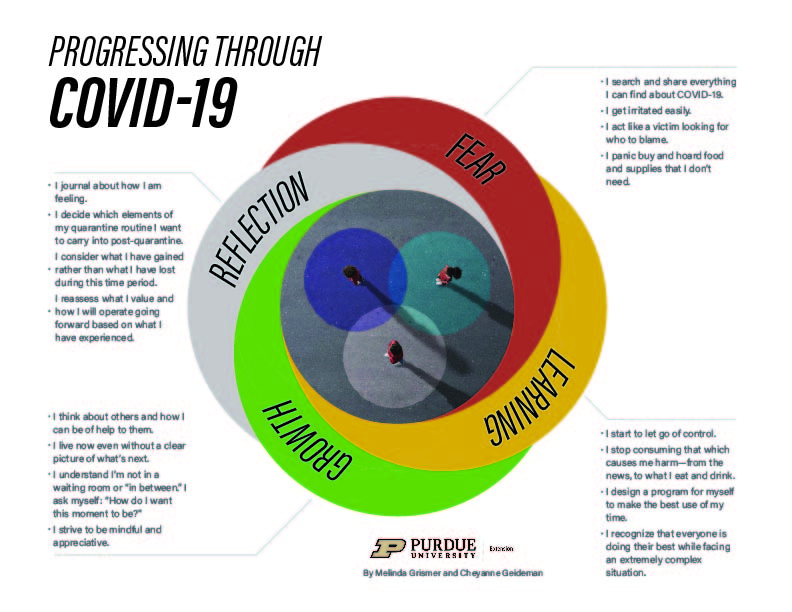A Graphic Reflection Tool
~by Cheyanne Geideman & Melinda Grismer

As any great leader knows, in order to lead effectively you must first meet people where they are. Every person’s experiences are different, and thus the way every community progresses through a pandemic will be different. During an informal NACDEP 2020 session, Grismer led a discussion using the graphic in figure one. Together, the group used this graphic to identify where their community is located on the COVID continuum. This graphic is not meant to be all encompassing, but merely a starting point for community conversation.
Having conversations about the current situation amongst local leadership during a pandemic is important, and research supports this. Branum et al. (2012) looked at leadership during pandemic influenza and found that “local needs and impact during pandemic response will be local, and local coordination is crucial to response.”
However, local leadership is not just elected officials. Branum et al. goes on to say that “leaders from all facets of a community will be looked upon to lead, communicate and make tough decisions during the pandemic.” Steve Cain, Virginia Morgan and Abby Lillpop concur with Branum et al. (2012), as their experiences show that volunteers are essential to disaster response. Cain et al. have a long history of working with community organizations active in disasters as well as non-profit and faith-based organizations. They found that “in every case, communities with collaborative groups working together to plan for a disaster response and recover will be more effective.”
Below are some of the highlights and main points from the NACDEP discussion around four stages in the continuum. Hopefully, you can use these to start discussion in your community development work as we progress through the remainder of 2020.
Fear Stage
Early on during COVID-19, as organizations, states and the nation were considering how to respond, it was interesting to observe how individuals responded to each other on an interpersonal level. The way people would normally react—panic, disbelief, anxiety, disregard—seemed to be amplified during the pandemic.
Some people moved past this stage more quickly than others. Some came back to fear with every new piece of information gained. And others are here again as their communities starts to open up and the new ”normal” is not as it once was.
When have you been in the fear stage? How do you see the fear stage demonstrated in your community? Remember: It is okay to be afraid; the important thing is what you do with the fear.
The following are some examples of this stage. Did you, your family or your friends/associates react in any of these ways?
- I search and share everything I can find about COVID-19
- I get irritated easily
- I act like a victim looking for who to blame
- I panic buy and hoard food and supplies that I don’t need
Learning Stage
This COVID-19 crisis has been frequently referred to as “the great pause.” During this stage, what described your attitude better, the COVID-19 theme song “Don’t Stop Believin’” (Journey) or “We’re Not Gonna Take It” (Twisted Sister)?
What is one ah-ha moment you had during this learning stage and how did it help you cope?
Examples of this stage include:
- I start to let go of control
- I stop consuming that which causes me harm—from the news, to what I eat and drink
- I design a program for myself to make the best use of my time
- I recognize that everyone is doing their best while facing an extremely complex situation
Growth Stage
Maintaining a network of social support was (and still is!) critical not only on a personal level, but also on a community level. One of the community development educators who recently participated in NACDEP’s (National Association of Community Development Extension Professionals) virtual hangout (where we discussed the graphic) commented that she has gained more insight into the perspectives of others during this time period. She shared the pain of role reversal as she found herself in the position to protect the health of her mother (who would normally be protecting her). Ultimately, through it all, we are in this together—no matter our age, race or gender.
How have you grown during COVID-19? How have the following strategies helped you, or continue to help you, as you strive to meet the needs of those around us?
- I think about others and how I can be of help to them
- I live now even without a clear picture of what’s next
- I understand I’m not in a waiting room or “in between.” I ask myself: “How do I want this moment to be?”
- I strive to be mindful and appreciative
Reflection Stage
All of us have a moment when we can breathe and reflect on our journey through COVID-19. At these points we recognize how far we individually or as communities have come and have insights into what we want to do in the future.
However, reflection should not be limited to the final stage, but be used in between each stage to help with the progression. Between each of these stages, using reflection techniques (like the ones listed below) helped us (and continue to help us!) transition from one stage to another. These best practices aren’t just good for getting you through COVID-19, they’re good for getting you through life:
- I journal about how I am feeling
- I decide which elements of my quarantine routine I want to carry into post-quarantine
- I consider what I have gained rather than what I have lost during this time period
- I reassess what I value and how I will operate going forward based on what I have experienced
References
This graphic reflection tool is based on the graphic widely circulated by a commercial real estate company for its employees (https://blauberg.com/news/covid-19/). With permission from the authors, Geideman and Grismer adapted the graphic based on COVID-19 experiences and observations.
Branum, Andrew, J. Eric Dietz, and David R. Black (2012). Pandemic Planning: Local Leadership in Pandemic Influenza (J. Eric Dietz and David R Black). CRC Press.
Cain, Steven Virginia Morgan and Abby Lillpop (2012). Pandemic Planning: Engaging Volunteer Organizations to Prepare for Pandemics. (J. Eric Dietz and David R Black). CRC Press.



